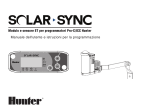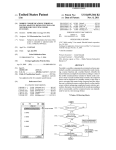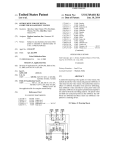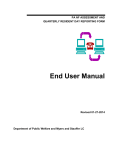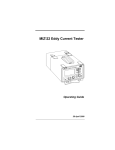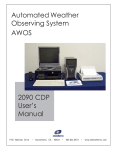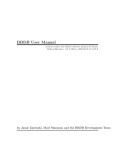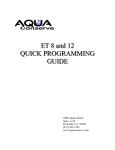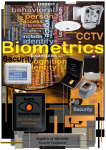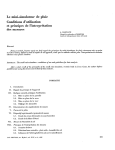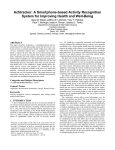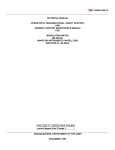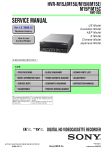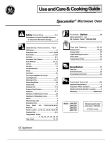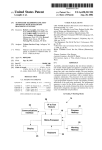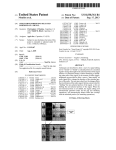Download \f j lmgallmcom`oller
Transcript
US008401705B2
(12) Unlted States Patent
(10) Patent N0.2
Alexanian
(54)
US 8,401,705 B2
(45) Date of Patent:
IRRIGATION CONTROLLER WATER
3,653,595 A
MANAGEMENT WITH TEMPERATURE
4/1972 Greengard et a1.
2
,
BUDGETING
ghaplrot l
,
ayer e
3,902,825 A
_
*Mar. 19, 2013
a .
9/1975 Quillen
4,010,898 A
3/1977 Williams
(76)
Inventor:
George Alexaman, Fresno, CA (US)
4,146,049 A
3/1979 Kmse et a1,
(*)
Notice:
Subject to any disclaimer, the term of this
patent is extended or adjusted under 35
U S C 154(b)b Oda S
4,176,395
4,185,650
4,208,630
4,209,131
A
A
A
A
4,265,403
A
4,333,490
A
~
~
~
'
y
y ~
'
'
'
'
Tlhis patent 15 subject to a terminal dis
_
RE31’023 E
C almer-
11/1979
1/1930
6/1980
6/1980
*
Evelyn-Veere
NeVe_S et 31
Mamnez
Barashet al.
5/1981
Bonetti
6/1982
Enter, Sr.
......................... .. 239/66
9/1982 Hall, In
4,396,149 A
8/1983 Hirsch
4,396,150 A
8/1983 Burrough
(21) Appl. No.: 13/274,255
4,431,338 A
2/1984 Hornabrook
(22)
4,502,288 A
4,526,034 A
3/1985 Lynch
7/1985 Campbell et a1.
Filed;
Oct 14, 2011
(65)
Prior Publication Data
US 2012/0072037 A1
4,545,396 A
10/1985 Miller et al.
4,548,225 A
10/1985 Busalacchi
(Continued)
Mar. 22, 2012
OTHER PUBLICATIONS
Related U's' Apphcatlon Data
(63)
“Report on Performance of ET Based Irrigation ControlleriAnaly
Continuation of application No. 12/955,839, ?led on
Nov. 29, 2010, Which is a continuation-in-part of
application No. 11/879,700, ?led on Jul. 17, 2007, noW
Pat. No. 7,844,368, Which is a continuation-in-part of
appl1cat1on No. 11/336,690, ?led on Jan. 20,
S_iS 0f op?ffation OfWeathefTRAK (TM) Controller in Field Condi
{1911s Dunng 2002,” Aquacfa?, 1110, APR 23, 2003*
C td
( on mue )
Primary ExamineriM_N_ Von Buhr
(Continued)
(74) Attorney, Agent, or Firm * Mark D. Miller
(51) Int. Cl.
(57)
G05D 1 1/00
A01G 25/00
(58)
(2006-01)
(2006-01)
ABSTRACT
The present invention provides methods for Water conserva
tion With irrigation controllers based upon the ambient tem
US. Cl- ........................................ ..
perature and extraterrestrial radiation of a particular geo
Field of Classi?cation Search ................ .. 700/284;
graphical area. It receives a preliminary irrigation schedule
239/67i70, 723; 137/78.1*78.3, 624.11*624.15,
137/624.21; 405/36, 37
from the operator and computes a Water budget ratio by
comparing current local geo-environmental data With stored
See application ?le for complete search history.
local geo-environmental data, then modifying the prelimi
Refel‘ellces Cited
nary irrigation schedule based upon that ratio. The present
invention utilizes feWer variables, is less complex, and is
(56)
much easier to install and maintain than the current evapo
US. PATENT DOCUMENTS
3,114,243 A
3,372,899 A
transpiration-based controllers.
12/1963 Winters
3/ 1968 McPhearson
16 Claims, 9 Drawing Sheets
10
12
Mama
\f j
/
lmgjal mcom'ol er
11
/
/
11\\
‘
many-mm
P
Samar
13
13\\
Transformer
Sensa-
Data
Dam
Smge
Shrage
D. Cfécwer
Supply
Solarcgower
//
14/
\
Supply
\
\
01M
Svltd'ues
‘\19
15
-__ 16
'
US 8,401,705 B2
Page 2
Related US. Application Data
2006, noW Pat. No. 7,266,428, Which is a continuation
in-part of application No. 10/ 824,667, ?led onApr. 13,
2004, noW Pat. No. 7,058,478.
(60) Provisional application No. 60/465,457, ?led on Apr.
25, 2003.
(56)
References Cited
U.S. PATENT DOCUMENTS
2/1986 Snoddy et al.
4,569,020 A
4,575,004 A *
3/1986
Geiger .......................... .. 239/69
4,613,077 A *
9/1986
Aronson ....................... .. 239/97
4,613,764
4,626,984
4,646,224
4,684,920
4,691,341
4,709,585
4,755,942
4,789,097
A
A
A
A
A
A
A
A
4,837,499
4,852,802
4,856,227
4,858,377
A
A
A
A
4,876,647 A
9/1986 Lobato
12/1986 Unruh et al.
2/1987
8/1987
9/1987
12/1987
7/1988
12/1988
6/1989
8/1989
8/1989
8/1989
10/1989
Ransburg et al.
Reiter
Knoble et al.
Altenhofen
Gardneret al.
Anderson et al.
Sherer,III
Iggulden et al.
Oglevee et al.
Oglevee etal.
Gardneret al.
4,913,351 A *
4/1990
4,921,001 A
5/1990 Pittsinger
Costa ............................ .. 239/74
4,922,433 A
5/1990 Mark
4,934,400 A
4,952,868 A
6/1990 Cuming
8/1990 Scherer,III
4,962,522 A
10/1990 Marian
4,967,789 A
11/1990 Kypris
4,992,942 A
2/1991 Bauerlie et al.
5,023,787 A
5,097,861 A
5,101,083 A
6/1991 Evelyn-Veere
3/1992 Hopkins etal.
3/1992 Tyler etal.
5,121,340 A
5,148,826 A
5,208,855 A
6/1992 Campbell et al.
9/1992 Bakhshaei
5/1993 Marian
5,229,937 A
7/1993 Evelyn-Veere
5,244,177 A
9/1993 Campbell et al.
5,251,153 A *
10/1993
5,321,578 A
5,341,831 A
5,355,122 A
6/1994 Morrison et al.
8/1994 Zur
10/1994 Erickson
5,375,617 A
5,444,611 A
12/1994 Young
8/1995 WoytoWitZ et al.
5,445,176
5,465,904
5,479,338
5,479,339
5,638,847
5,696,671
5,836,339
5,839,660
8/1995
11/1995
12/1995
12/1995
6/1997
12/1997
11/1998
11/1998
A
A
A
A
A
A
A
A
Nielsen etal. .............. .. 700/284
Goff
Vaello
Ericksen et al.
Miller
Hock, Jr. et al.
Oliver
Klever et al.
Morganstern et al.
5,853,122 A
12/1998 Caprio
5,870,302
5,908,157
5,921,280
5,960,813
6,076,740
6,088,621
6,098,898
6,102,061
6,145,755
2/1999
6/1999
7/1999
10/1999
6/2000
7/2000
8/2000
8/2000
11/2000
A
A
A
A
A
A
A
A
A
Oliver
Antonellis et al.
Ericksen et al.
Sturman etal.
Townsend
WoytoWitZ et al.
Storch
Addink
Feltz
6,173,727 B1*
1/2001
6,227,220 B1
6,250,091 B1
6,259,955 B1
5/2001 Addink
6/2001 Jerome
7/2001 Brundisiniet al.
6,267,298 B1
6,298,285
6,314,340
6,343,255
6,401,742
B1
B1
B1
B1
6,402,048 B1*
Davey ............................. .. 137/1
7/2001 Campbell
10/2001
11/2001
1/2002
6/2002
6/2002
Addinket al.
Mechametal.
Peek et al.
Cramer et al.
Collins ......................... .. 239/63
6,452,499
6,453,215
6,453,216
6,585,168
6,589,033
6,675,098
6,714,134
6,748,327
6,766,817
6,795,767
6,823,239
6,892,113
6,892,114
6,895,987
6,918,404
6,944,523
6,947,811
6,950,728
6,963,808
7,010,394
7,048,204
7,050,887
7,058,478
7,058,479
7,063,270
7,066,586
7,096,094
7,165,730
7,236,908
7,243,005
7,248,945
7,266,428
7,286,904
7,317,972
7,330,796
7,337,042
7,363,113
7,403,840
7,406,363
7,412,303
7,413,380
7,430,458
7,444,207
7,513,755
7,522,975
7,532,954
7,552,632
7,584,023
7,596,429
7,613,546
7,640,079
7,769,494
7,805,221
7,810,515
7,853,363
7,877,168
7,957,843
8,145,357
2001/0049563
2002/0002425
2002/0010516
2002/0020441
2002/0027504
2002/0060631
2002/0072829
2002/0091452
2002/0092954
2003/0025400
2003/0080199
2003/0109964
2003/0178070
2003/0179102
2003/0182022
2003/0183018
2003/0208306
2003/0230638
2004/0011880
2004/0015270
2004/0039489
9/2002
9/2002
9/2002
7/2003
7/2003
1/2004
3/2004
6/2004
7/2004
9/2004
11/2004
5/2005
5/2005
5/2005
7/2005
9/2005
9/2005
9/2005
11/2005
3/2006
5/2006
5/2006
6/2006
6/2006
6/2006
6/2006
8/2006
1/2007
6/2007
7/2007
7/2007
9/2007
10/2007
1/2008
2/2008
2/2008
4/2008
7/2008
7/2008
8/2008
8/2008
9/2008
10/2008
4/2009
4/2009
5/2009
6/2009
9/2009
9/2009
11/2009
12/2009
8/2010
9/2010
10/2010
12/2010
1/2011
6/2011
3/2012
12/2001
1/2002
1/2002
2/2002
3/2002
5/2002
6/2002
7/2002
7/2002
2/2003
5/2003
6/2003
9/2003
9/2003
9/2003
10/2003
11/2003
12/2003
1/2004
1/2004
2/2004
Runge et al.
Lavoie
McCabe et al.
Caprio
Johnson et al.
Peek et al.
Addink et al.
Watson
da Silva
Nakamoto et al. .......... .. 701/115
Sieminski
Addink et al.
Addink et al.
Addink et al.
da Silva
Addink et al.
Addink et al.
Addink et al.
Addink et al.
Runge et al.
Addink et al.
Alvarez
AleXanian
Miller
Bowers et al.
da Silva
Addink et al.
Clark et al.
Timko et al.
Beutler et al.
WoytoWitZ
AleXanian
Graham
Addink et al.
Addink et al.
Marian et al.
Runge et al.
Moore et al.
Doering et al.
Porter et al.
CorWon et al.
Dansereau et al.
Nickerson et al.
Geisinger et al.
Perez
Evelyn-Veere
Runge et al.
Palmer et al.
Cardinal et al.
Nelson et al.
Nickerson et al.
Simon et al.
Nickerson
Nies et al.
Porter et al.
Porter et al.
Sacks
Nibler et al.
Addink et al.
Dossey et al.
Addink
Addink
Davis
Runge et al.
Addink et al.
Addink et al.
Addink et al.
Hall
Condreva
Addink et al.
Glicken
Barnes
Addink et al.
Addink et al.
Addink et al.
Dukes et al.
Addink et al.
Addink et al.
Moore et al.
US 8,401,705 B2
Page 3
2004/0089164
2004/0117070
2004/0217189
2005/0019184
2005/0137752
A1
A1
A1
A1
A1
2005/0187665 A1*
5/2004 Addink et a1.
6/ 2004 Barker
1 1/2004 Regli
1/2005 Geisinger et al.
6/2005 Alvarez
8/2005
Fu ............................... .. 700/284
2005/0250440 A1
11/2005 Zhou et al.
2005/0279856 A1*
12/2005
2006/0043208
2006/0091245
2006/0116792
2006/0122735
2006/0155489
2006/0217846
2006/0293797
2007/0016334
2007/0156318
2007/0179674
2007/0191991
2007/0221744
2007/0282486
2007/0293990
2008/0027586
2008/0119948
2008/0167931
2009/0043427
2009/0094097
2009/0138105
2009/0202366
2009/0281672
2010/0030389
2010/0030476
2010/0094472
2010/0106337
2010/0145530
2010/0256827
2010/0312404
2011/0077785
2011/0238229
A1
A1
A1
A1
A1
A1
A1
A1
A1
A1
A1
A1
A1
A1
A1
A1
A1
A1
A1
A1
A1
A1
A1
A1
A1
A1
A1
A1
A1
A1
A1
3/2006
5/2006
6/2006
6/2006
7/2006
Nalbandian et al. .......... .. 239/76
Graham
Ivans
Addink
Goldberg et al.
Addink
9/2006 WoytowitZ
12/ 2006
1/2007
7/ 2007
8/ 2007
8/2007
9/2007
12/ 2007
12/ 2007
1/2008
5/ 2008
7/ 2008
2/ 2009
4/2009
5/ 2009
8/ 2009
1 1/ 2009
2/2010
Weiler
Smith et al.
Anderson et al.
Ensworth et al.
Addink
Simon et al.
Walker et al.
Alexanain
Hern et al.
O’Connor
Gerstemeier et al.
Addink
Garden swartZ
Crawford
Geisinger et al.
PourZia
Palmer et al.
2/2010 WoytowitZ
4/2010 WoytowitZ
4/2010
6/2010
10/2010
12/2010
3/2011
9/2011
Sacks
Nickerson
Bragg et al.
Nickerson
Nickerson et al.
WoytowitZ et al.
OTHER PUBLICATIONS
Engineer’s Notebook No. 106, A Simple Evapotranspiration Model
for Hawaii: The Hargreaves Model; CTAHR Fact Sheet, l-page
article, May 1997, WU.
Austin Lawn Sprinkler Association, Technical Information-Using
Evapotranspiration Data; Nov. 2002, l-page webpage.
ET Different Formula, l-page Chart.
USFAO, Preface page Web Page, Feb. 2003.
US Department of the Interior Bureau of Reclamation Lower Colo
rado Region Southern California Area Of?ce, Temecula,
California & Technical Service Center Water Resources Planning
Operations Support Group, Denver, Colorado; Weather and Soil
Moisture Based Landscape Irrigation Scheduling Devices; Reclama
tion Managing Water in the West, Aug. 2004; 135 pages.
Instructions, Model PK-lB pump controller, Mar. 1993.
“Irrigation & Green Industry” Magazine, Nov. 2010.
Universal Smart Module brochure, Aug. 2009.
Smart Clock brochure, original from approx. May 2007.
WeatherSmartPro brochure, Oct. 2009.
Aqua Conserve User’s Guide, Jun. 2010.
Aqua Conserve ET-8 Series Manual, 2010.
Climate Logic wireless weather sensing system ?yer, Nov. 2010.
WeatherSmart manual, Mar. 2010.
Irritrol, “Climate Logic” user manual, 2011.
Rain Bird, Simple-to-Set Smart Controller Operation Manual, 2010.
Hunter, X-Core residential irrigation controller manual, 2010.
Solar Sync sensors, 2011.
Metropolitan Water District of Southern California, The Watering
Index and Watering Calculator, 2011.
Metropolitan Water District of Southern California, Save a Buck:
Irrigation Controllers, 2011.
Enercon Plus Brochure, original from approx. May 2007.
WeatherSmartPro brochure, Mar. 2010.
SolarSync brochure, Oct. 2009.
SolarSync Owner’s Manual and Programming Instructions, Dec.
2009.
Toro ECXTRA Automatic Sprinkler System Control Timer, User’s
Guide.
Toro XTRA SMART Wireless weather sensor system installation and
“Reclamation, Managing Water in the WestiWeather Based Tech
setup guide.
nologies for Residential Irrigation Scheduling,” Technical Review
Report, US. Dept. of the Interior, May 2004.*
AquaConserve ACT-9 and ACT-14 Station Aqua Climate Tracker
Hunt, T. and Lessick, D. et al., Residential Weather-Based Irrigation
Scheduling: Evidence from the Irvine “ET Controller” Study (2001).
List of Principal Symbols and Acronyms; 2003, ?ve web pages.
Cattaneo & Upham, Methods to Calculate Evapotranspiration Dif
ferences and Choices, 3-page article.
AquaConserve ACT-9 and ACT-14 Quick Reference & Installation
Water-Ef?cient Landscaping; 2001, 2-page article.
The Irrigation AssociationiWater Management Committee, Turf
and Landscape Irrigation Best Management Practice, Appendix G,
De?cit Irrigation Practice.
Irrigation Controller User’s Guide (2001).
Guide (2001).
TORO Xtra Smart Wireless Weather Sensor System Installation and
Setup Guide (2010).
“Report on Perofrmance of ET Based Irrigation ControlleriAnaly
sis of Operation of WeatherTRAK (TM) Controller in Field Condi
tions During 2002,” Aquacraft,lnc. Apr. 23, 2003.
* cited by examiner
US. Patent
Mar. 19, 2013
US 8,401,705 B2
Sheet 1 0f 9
TEMPERATURE VS. ET
IRRIGATION BUDGET
100%
95%
90%
35%
80%
g 15%
g 70%
:5?
3z 50%
52!;
—¢—Temp Budget
E» 45%
+E..T
3 40%
:21:
Z 25%
20%
15%
10%
5%
0%
Jan
Feb
Mar
Apr
May
Jun
Jul
Aug
Sep
Oct
Month
Month
Temp Budget
ET
Jan
Feb
25.61%
32.61%
23.18%
29.82%
Mar
' 56.31%
53.62%
Apr
May
Jun
Jul
Aug
‘Sep
72.02%
88.90%
97.90%
100.00%
94.09%
69.78%
72.23%
88.47%
96.19%
‘100.00%
92.93%
70.39%
Oct
Nov
Dec
51.06%
34.09%
25.98%
53.07%
2909%
25.67%
Fig. 1
Nov
Dec
US. Patent
Mar. 19, 2013
Sheet 2 019
US 8,401,705 B2
10
12
mtenna~\:
/
f
lm‘ga?on Controller
[11 '
1 7\
\
Remoteiy - Programmable
Temperature
Processor
lnputDem'ce
Sensor
1
13\
13
Transformer
\‘
or
Precipiia?on
Data
Data
Sensor
Storage
Storage
D- C- POwer
Supply
OI‘
Solar Power
/
14/
/
Su pply
\\
\
Cutoff
15
Switches
“\ 1 9
Fig. 2
16
M,”
US. Patent
Mar. 19, 2013
Sheet 3 of9
US 8,401,705 B2
/18'
17 \MH
r~—"21
10‘———
---- 20
A
\_____/
Fig. 3
US. Patent
Mar. 19, 2013
Sheet 4 019
US 8,401,705 B2
Operator Installs Irrigation Controller ‘
.
‘L
\ 30
.
Operator attadles cuto? swim
lo exislr'ng irrigation system
Controller Calculates Penoo'lc Temperawre
_\
I
/I
31
Budget Elector (PTBF)
‘50
Operator installs temperature sensor
wilhin target geographical
l
area
Record max-mum tam
-\ 32
61 /_
(Op?onal) Operator installs precipitation
sensor
‘\ 33
awe
for the mm,‘
1
52 /, Deiemline RAforl me current period
V
Determine PTBF ?‘om periodic
operator Con?gures lrriga?on Conh'oller
\
63/
40
Operator enters current lime date,
mmlh and year
“mum ‘em'mm‘e 8"“ RA
$
~\
[
CmlrollerAlfeclsPrellminarylrrigallm
4‘
Operator enters expected summer high
tam‘
re (TSMAX) and ‘is date \42
70 /
Calculate water budget ra?on (WBR)
l
Operator enters latitude for geographirnl
area or zip code
Sdredule
71
/,
\
I
43 a’)
.
from STBF and PTBF
1
.
r AdjJst irrigation schedule by WBR
.
72 /
Operator alters prelimlnary lmgalion
schedule
I
~\
I
44
/,
(Optional) Operator enters minimum
system ac?valion lernperalure __\45
Conlroller Calculates Summer Temperamre
Budget Factor (STBF)
‘L
/
,
mam System mvam
a0 /
50
Obtain exlraleneslrall radlalion value
?'om RA lookup table
_
l
Store adjusted irriga?on schedule
73
(Optional) Verify temperalure is grealer
/ than minimum activalion lemperamre
31
L
\51
Determine STBF from average summer
4
.
..
.
82 / (Optimal) Venfy ‘ad of “summon
temperalure and RA
1
\52
.
.
,.
.
83 /_ Acllvate adpsted lmgatron schedule
Fig. 4'
US. Patent
Mar. 19, 2013
Sheet 5 0f 9
Controller Calculates Summer Temperature
Budget Factor (STBF)
L
Obtain erdraterrestriat radiation
value from RAlookup table
l
Determine STBF from average summer
temperature and RA
l
Controller Calculates PBliOG'tC Temperature
BudgetFactor (PTBF)
Record maximum temperature for the
“
current period
52 ~.____ Determine RAtor the current period
Determine PlBF from periodic
63 ‘
71
\‘
maximum temperature and RA
Calculate water budget ration (WBR)
from STBF and PTBF
72 --_.i. Adiist irrigation sdtedute by WBR
73 \_ Store ?djJStEd irrigation schedule
30x
irrigation System Activation‘
33 _._____ Activate adtlsted irrigation schedule
Fig. 5
US 8,401,705 B2
US. Patent
Mar. 19, 2013
Sheet 9 019
K320Qc556:oEs?;023n9mE .02.5<>220$6>3089o2504z3. 3520:061
0.30N03013N330.033N.8R03 #0“mm.8R03 00N.R03 30N#03.033 0N“03.033 “03~3.3103 0#~53N3.303 0.030N3#N03.303 3v.30531p0.30.N03 0533“0.03 00.3N033Q.03 0p“35N.03 0“0.33#0.03
E
5
i
60
830
:0
a:
$30
US 8,401,705 B2
US 8,401,705 B2
1
2
IRRIGATION CONTROLLER WATER
MANAGEMENT WITH TEMPERATURE
BUDGETING
municipal and commercial areas, golf courses and schools
further contribute to the Water shortage.
Such Water shortages have forced many municipalities to
enact strict Water conservation measures. For its part, the
This is a continuation of US. Utility patent application Ser.
No. 12/955,839 ?led on Nov. 29, 2010, Which is a continua
tion-in-part of application Ser. No. 11/879,700 ?led on Jul.
m
and required the installation of Water meters and auditors to
enforce those schedules. Commercial and environmental
17, 2007, now US. Pat. No. 7,844,368, Which is a continua
tion-in-part of US. Utility patent application Ser. No. 1 1/ 336,
users have enacted similar measures. HoWever, there is no
690 ?led on Jan. 20, 2006, now US. Pat. No. 7,266,428,
consensus among these various consumers as to the most
Which is a continuation-in-part of US. Utility patent applica
tion Ser. No. 10/824,667 ?led onApr. 13, 2004, now US. Pat.
effective Water conservation method or automated control
system.
No. 7,058,478, Which claims the bene?t of US. Provisional
Residential and commercial irrigation consumers are
Application No. 60/465,457 ?led on Apr. 25, 2003, all of
Which are incorporated herein in their entirety by this refer
responsible for a signi?cant percentage of Wasted Water. A
ence.
The speci?cation, abstract and drawings herein are identi
cal to (and a continuation of great-great grandparent) U.S.
Utility patent application Ser. No. 10/824,667 ?led on Apr.
agricultural industry has responded to this shortage by resort
ing to drip, micro and other loW-volume irrigation systems.
Urban communities have imposed strict irrigation schedules,
20
13, 2004, now US. Pat. No. 7,058,478.
BACKGROUND OF THE INVENTION
report entitled “Water Ef?cient Landscaping” by the United
States Environmental Protection Agency (EPA), dated Sep
tember 2002, publication number EPA832-F-02-002, states
the folloWing: “[a]ccording to the US. Geological Survey, of
the 26 billion gallons of Water consumed daily in the United
States (Amy Vickers, 2002 “Handbook of Water Use and
Conservation”), approximately 7.8 billion gallons, or 30% is
devoted to outdoor uses. The majority of this is used for
landscaping”
1. Field of the Invention
The present invention relates to the management and con
25
servation of irrigation Water, primarily for, but not limited to,
residential and commercial landscaping applications, and
more speci?cally, to a greatly simpli?ed method for doing so
based upon seasonal temperature variations and geographic
30
A signi?cant reason for this over-utiliZation of landscape
Water Was revealed in a marketing study conducted by the
Irrigation Association (IA) and presented at the 2003 IA
“Smart Water Application Technology” conference in San
Diego, Calif. The study indicated that most consumers typi
cally adjust their irrigation schedule only tWo to ?ve times per
locations.
year, rather than on a daily or Weekly basis, regardless of
2. Description of the Prior Art
Many regions of the United States lack su?icient Water
resources to satisfy all of their competing agricultural, urban,
changes in environmental conditions. The relatively high co st
of labor in many municipalities further prohibits frequent
manual adjustments of irrigation controllers. This generally
results in over-irrigation and runoff, particularly during the
commercial and environmental needs. The “California Water
35
Plan Update, Bulletin 160-98,” published by the California
off-seasons, oftentimes by as much as one to tWo hundred
Department of Water Resources using 1995 calendar year
data, estimated that approximately 121.1 million acre feet
(maf) of Water is needed to satisfy the annual Water needs of
the State of California alone. Of this amount, approximately
forty-six percent is required for environmental purposes,
forty-three percent for agricultural purposes, and eleven per
cent (approximately 13.3 maf) for usage in urban areas. The
percent. Furthermore, in municipalities that limit irrigation to
Bulletin further estimated that California suffers a shortage of
1.6 maf during normal years, and 5.1 maf in drought years.
certain days or intervals, the common practice is to over
40
Water during the permitted Watering periods in order to “carry
over” until the next Watering period. HoWever, this practice is
45
counter-productive, in that severe over-irrigation results in
increased Water run-off and evaporation.
Soil moisture sensing devices and other methods of Water
conservation, have been available for decades, but have
enjoyed only limited success. Such devices and methods gen
These shortages are expected to increase steadily through the
erally call for inserting moisture sensors into the soil to mea
sure the soil moisture content. NeWer soil moisture sensing
year 2020 due to expected signi?cant increases in the state
population.
At the Feb. 17, 2004, EPA-sponsored “Water Ef?cient
Product Market Enhancement Program” in Phoenix, AriZ.,
for landscaping irrigation systems and controllers, it Was
50
technologies have more recently been developed, and claim
to be theoretically accurate in measuring plant Water needs.
HoWever, regardless of the level of technology, such devices
and methods are often problematic due to the location and
projected that thirty-six states Will have severe Water short
number of sensors necessary to obtain accurate soil moisture
ages by the year 2010. A signi?cant portion of this projected
readings, the high costs of installing and maintaining the
shortage Was attributed to user neglect and irrigation control
ler inef?ciency. The 2003 California census revealed that
there Were over tWenty million single family residences and
apartments Within the state. The California Urban Water Con
servation Council estimated that the average household uti
liZed one-half acre foot of Water (162,500 gallons) annually,
and that ?fty-?ve percent (89,375 gallons) of this amount Was
55
sensors, and the integrity and reliability of the sensors data.
Other irrigation controllers utiliZe meteorological data to
estimate the evapotranspiration, or ET, for a particular region.
This ET represents the amount of Water needed by plants to
replace Water lost through plant absorption and evaporation,
60
and is expressed in inches or millimeters of Waterper day. The
United States Food and Agriculture O?ice (USFAO), in its
Irrigation and Drainage Paper No. 24, entitled “Crop Water
used for landscape irrigation. It further estimated that
approximately one-third of the irrigation Water Was Wasted,
Requirements,” noted that “a large number of more or less
either due to inef?cient irrigation systems or inadequate con
empirical methods have been developed over the last ?fty
troller programming, oftentimes due in part to complicated
years by numerous scientists and specialists WorldWide to
estimate ET from different climatic variables.”
controller programming procedures required of the operator.
This results in a total annual Waste of 1.81 maf of Water for
California households alone. Excessive Water usages in
65
There are at least 15 different ET formulas. Each of these
formulas provides a different result for the reference ET
US 8,401 ,705 B2
3
4
(ETo). In their paper entitled “Methods to Calculate Evapo
6,298,285. All of these methods calculate ETo values or
receive them from external sources, and use such values to
transpiration: Differences and Choices,” Diego Cattaneo and
Luke Upham performed a four-year comparison of four dif
adjust and regulate irrigation. Such external sources may be
ferent ETo formulasithe Penman-Monteith formula, the
SchWab formula, the Penman formula, and the Penman pro
gram. The comparison revealed that the results from the four
CIMIS ET databases, local sensors, cable lines or broadcast
stations. Several of these methods also utiliZe other data, such
as precipitation.
Unfortunately, methods incorporating ET formulas, and
the installation, comprehension and programming of control
lers utiliZing such methods, including those cited in the ref
recognized formulas sometimes varied by as much as sev
enty-?ve percent.
The Penman-Monteith formula is currently recommended
as the “standard” by both the USFAO and California Irriga
erenced patents above, are far too complex for the average
tion Management Information System (CIMIS), With vari
user to understand and implement. Such a conclusion Was
ances of less than tWenty percent considered ideal. The Pen
reached in a recent study of ET controllers by the Irvine
Ranch Water District, entitled “Residential Weather Based
man-Monteith formula is as folloWs:
Irrigation Scheduling Study.” The study stated the folloWing:
“The Water agency solution to date has been to conduct resi
dential audits, leaving the homeoWner With a suggested
Watering schedule, hoping it Would then be folloWed. These
37
y Ta + 273.16 [MES _ E“)
ET
0
=
MA + Y(1+ car/2)
The variables Within this formula represent the folloWing:
EToIgrass reference evapotranspiration in millimeters per
programs have had limited effect and a short-term impact. A
20
day.
expensive for residential applications.”
A:slope of saturation vapor pressure curve kPao C. at the
mean air temperature.
RnInet radiation (MJm_2h_ l ).
25
related to ET theory and its various formulas, covering such
variables as: the capillary rise; the resistance correction fac
tor; the soil heat capacity; the psychrometer coe?icient; and
U2qvind speed at tWo meters (m s_l).
30
explain, understand and apply, especially for an unsophisti
cated consumer With little or no scienti?c or meteorological
temperature in o C.
7t:latent heat of vaporization (MJkg_l).
35
background. For example, the manual for one ET-based con
troller currently on the market comprises over one hundred
?fty pages of instructions and explanations. Such unfamiliar
ity and complexity increase the margins of error already asso
ciated With the various ET formulas, further diminishing their
posed by the College of Tropical Agriculture and Human
Resources at the University of HaWaii at Manoa. Its equation
is described in the College’s Fact Sheet Engineer’s Notebook
No. 106, published May 1997, in an article entitled “[a]
Simple Evapotranspiration Model for HaWaii,” as folloWs:
the bulk stomatal resistance of a Well-illuminated leaf. The
sheer number of variables renders ET theory dif?cult to
temperature in o C.
Ea:actual vapor pressure (kPa) at the mean hourly air
Cd:bulk surface resistance and aerodynamics resistance
coe?icient.
The simplest ET formula is the Hargreaves formula pro
Such complexity is underscored by the one hundred forty
?ve principal symbols and acronyms identi?ed by the
USFAO for use and description of the factors and variables
G:soil heat ?ux density (MJm_2h_1).
Yrpsychrometric constant (kPao C.).
TaImean hourly air temperature (° C.).
Es:saturation vapor pressure (kPa) at the mean hourly air
preferred solution Would be to install irrigation controllers
that automatically adjust Watering times based on local
Weather conditions. Unfortunately, until noW, these large
landscape control systems have been far too complex and
effectiveness.
40
Water districts, irrigation consultants, manufacturers, the
Irrigation Association, the Center for Irrigation Technology
and other attendees at the EPA’s Water Ef?cient Product
Market Enhancement Program estimated that, due to the
complexity, cost, impracticality of installation and dif?culty
The variables Within this formula represent the folloWing:
45
ETorpotential daily evapotranspiration in mm/ day.
TImean daily temperature (° C.).
systems currently and effectively utiliZe some form of the ET
or moisture sensing method. Such scattered adoption exists
despite over ?fty years of ET research, and over thirty years of
RsIincident solar radiation converted to millimeters of
Water per day (MJ).
This formula is theoretical and, to the inventor’s knowledge,
untested. Furthermore, it relies upon the same ET theories
and interrelationships as the other formulas disclosed above.
As described herein, such reliance causes the Hargreaves
formula to possess the same shortcomings as the other ET
formulas.
in programming current irrigation controllers, less than one
percent of all commercial and residential landscape irrigation
50
ground moisture sensing technology. The magnitude of such
ineffectiveness is underscored by the fact that there are over
tWo million neW controllers installed annually in the United
States alone, and over ?fty million controllers in use today.
55
A number of irrigation controller manufacturers offer
Even if the ET or ground moisture sensing methods provided
one hundred percent ef?ciency, Which they do not, the limited
adoption of these methods renders them an ineffective means
“smart” (self-adjusting) irrigation controllers. Such control
of signi?cant Water conservation, since only one percent of
lers generally incorporate some form of ET. Several of them
obtain the environmental data to calculate ET from historical
records, While others utiliZe adjacently located Weather sta
tions to obtain real-time data. Others receive such informa
tion from a netWork of existing Weather stations by radio,
the runoff and Water Waste Would be prevented under per
fectly-ef?cient conditions.
60
data. As indicated above, many variables must be measured in
order to calculate ET. Data for each variable must be obtained
by separate sensors, each one installed in a particular loca
satellite or pager means.
The following US. patents all disclose various methods by
Which an irrigation controller calculates or adjusts an irriga
tion schedule based upon historical, distal, or local ETo: US.
Pat. Nos. 4,962,522; 5,208,855; 5,479,339; 5,696,671; and
A second shortcoming of the ET method is its dependence
upon numerous categories of local, real-time meteorological
65
tion. Such particularity requires an understanding of local
environmental conditions and meteorology. Furthermore,
accuracy requires that the data be received from local sen
US 8,401,705 B2
5
6
sorsigiven the numerous microclimates existing Within any
one geographical area, data received from remotely located
much less a consumer, to understand, such as: the local land
sensors may be inaccurate. The data must also be received and
depending upon the particular soil composition; alloWable
processed in real-time, since average or historical ET data
may be inaccurate during periods of unusual or excessive
heat, cold, or rain, or other deviations from historical climate
patterns. Any inaccurate data Would result in even greater ET
Water depletion rate from the root Zone; maximum percentage
ment factor necessary to overcome Water management inef
deviations and inef?cient irrigation.
ET measuring devices are generally also expensive to
?oW rates for the particular system; and, of course, ET.
Due to the urgency arising from severe national drought
and environmental conditions, and the shortcomings of the
scape coef?cient for the particular vegetation; available Water
alloWable depletion Without plant stress; the Water manage
?ciency; the Whole day stress-based irrigation interval; Water
install and maintain. Sensors or Weather stations must be
placed Within each microclimate to measure the different
variables utiliZed by the formula of choice. Each Weather
station may cost up to several thousand dollars. Furthermore,
all of these sensors or stations must undergo regular inspec
tion, maintenance and calibration to insure that they continue
to provide accurate data. This further increases the actual cost
of each station. The sensors and stations must also be poWered
in some manner4depending upon the particular geographic
location, AC poWer may not be readily available. All of these
various present technologies, the irrigation industry is cur
rently researching alternative methods for Water conservation
and prevention of unattended runoff. The Center for Irrigation
Technology in Fresno, Calif., along With other educational
and research institutions and Water conservation agencies, is
conducting studies to determine the most effective Water con
20
considerations increase the cost of implementing an
ET-based irrigation system to a prohibitive level, and limit the
Widespread adoption of this method. Finally, all of this
consumer aWareness and compliance as an alternative to
mandated Water conservation measures Which Would
assumes that the Weather station or sensors is even installable
in a particular areaisome areas, such as street medians or 25
parks, are not suitable for Weather station or sensor installa
tion due to aesthetic reasons or the likelihood of vandalism.
Another shortcoming of ET-based controllers is that all of
the ETo formulas (including the Hargreaves formula) are
generally expressed in hundredths of an inch, or millimeters,
severely and negatively impact the irrigation industry, land
scape aesthetics and the ecology.
It is clear from the foregoing discussion that the irrigation
Water management industry, in vieW of a politically and eco
30
of Water per day. Thus, ETo must be converted to an actual
irrigation time of minutes. Such a conversion is dependent
upon the characteristics of the particular hydraulic system,
nomically sensitive, and urgent, Water crisis, is pursuing
highly scienti?c, mathematical and/or technical approaches
for resolving the problems of Wasted irrigation Water and
drought conditions. Unsurprisingly, such approaches have
met With limited success. The EPA, United States Department
of Energy (DOE), ecologists, environmentalists, municipali
such as the valve siZes, Water ?oW rates, and sprinkler or drip
irrigation precipitation rates. One conversion formula, pro
servation method. On the national level, the EPA is consider
ing the introduction of a “WaterStar” irrigation ef?ciency
rating program similar to the “EnergyStar” rating system
currently in use for equipment energy e?iciency. The purpose
of such an irrigation ef?ciency rating program is to promote
ties, Water agencies, and research institutions are all search
35
posed by the Austin (Texas) LaWn Sprinkler Association,
calculates the sprinkler run time in minutes (T) as folloWs:
ing for neW methods that provide practical (as opposed to
theoretical) irrigation ef?ciencyimethods that overcome the
particular shortcomings of the prior art.
Landscape Water conservation also provides additional
bene?ts. As noted by the EPA in its “Water Ef?cient Land
40
The variables Within this equation represent the folloWing:
ETo:reference evapotranspiration rate, in inches.
Kc?he percentage crop coef?cient.
Pr?he sprinkler precipitation rate, in inches per hour.
45
extended life for Water resources infrastructures (e.g. reser
voirs, treatment plants, groundWater aquifers), thus reduced
taxpayer costs.” Thus, there is an urgent need for irrigation
50
Determining the precipitation rate (Pr) requires knoWledge of
the hydraulic system speci?cationsithe particular types of
Another ET-to-irrigation-time conversion method, the
‘de?cit irrigation practice,’ Was proposed by the IA Water
Management Committee in Appendix G of its October 2002
article entitled “Turf and Landscape Irrigation Best Manage
their schedules periodically in response to meteorological
and seasonal changes.
The problem of irrigation mismanagement, and the main
55
60
hurdle faced by these entities, can be simply summarized as
folloWs: once a system is properly designed, most of the
Wasted landscape irrigation Water and runoff is caused by not
adjusting for daily, periodic, or seasonal changes. Such inac
tion is usually caused by the complexity and dif?culty of
determining the particular adjustment amounts. With that in
mind, a correspondingly simple intuitive solution Would be
highly preferred over the existing highly theoretical and tech
nical, but impractical, state of the art in moisture sensing and
ET-based control systems.
ment Practices.” Such conversion method comprised of ten
separate formulas, and utiliZed a total of tWenty-nine vari
ables and constants, not including those utiliZed in calculating
the ET value. Many of these variables represented concepts
and relationships dif?cult for the average irrigation designer,
systems that conserve Water and energy, and minimiZe nega
tive impact upon the environment, by automatically adjusting
valves and sprinklers, the number of valves and sprinklers
Within the system, the Water ?oW rate and operating pressure.
Such information is not readily available to the average con
sumer. Instead, the consumer must expend additional time
and money to retain an irrigation expert to con?gure and
install the system.
irrigation Water that carries top soils, fertilizers, and pesti
cides into lakes, rivers, and streams, feWer yard trimmings,
reduced landscaping labor and maintenance costs, and
Ea?he percentage application ef?ciency of the hydraulics
system.
As an example of such complexity, the crop coe?icient (Kc)
is different for each crop or landscape plant or grass type.
scaping” guidelines, landscape Water conservation also
results in “decreased energy use (and air pollution associated
With its generation) because less pumping and treatment of
Water is required and reduced runoff of storm Water and
65
It is therefore desirable to provide a simple, user-intuitive,
and therefore readily accepted Water conservation approach,
particularly for a clearly understood automated method of
US 8,401,705 B2
7
8
calculating and implementing irrigation schedules. It is fur
from. This placement minimiZes the pro?le of the controller,
increasing the aesthetic appeal of the surrounding environ
ther desirable to provide a method that does not necessarily
rely upon ground or air moisture sensing means, Weather
ment and reducing the likelihood of vandalism. The controller
stations, or ET (either directly, or as a basis for deriving the
utiliZes Wireless communication means (such as radio or
sprinkler operating times). It is further desirable to provide a
infrared), alloWing the operator to program the apparatus
method that minimiZes the margins and sources of errors by
remotely. A temperature sensor is installed Within the pipe at
a position that minimiZes sun-loading effects. Such a location
may be near or just beloW ground level, or on top of the pipe
under a shaded and ventilated cover. An optional precipitation
minimizing the number of sensor inputs required by the vari
ables in the formula. It is further desirable to provide a method
that utiliZes minimal local, real-time meteorological data. It is
further desirable that such a method be cost-e?icient, afford
sensor, With or Without a rain-catcher, may be mounted at the
able and usable by a large number of people and entities
top end of the pipe to detect rainfall, or at another location in
Within the different industries. It is further desirable that such
a method be understandable by the average consumer. It is
further desirable that such a method be accomplished auto
Wired or Wireless communication With the controller.
The preferred embodiment is battery-powered, using com
mercially available technology emphasiZing energy conser
vation and the long-distance operation of irrigation valves.
Signi?cantly extended battery life, and the extended range of
DC valve operations, alloWs the controller to be placed in
matically, Without requiring regular manual adjustments by
the operator of the irrigation Watering time settings or sched
ules.
remote areas, Without the need for AC poWer or solar panels.
SUMMARY OF THE INVENTION
20
appeal. It also eliminates the installation and maintenance
cost of poWer meters, and their unattractiveness in the land
The present invention provides a simple and automated
method for Water conservation and management, one Which
minimiZes runoff, and is totally independent of ground or air
moisture sensing, measured solar radiation, Weather stations,
ET, or complicated formulas for calculating irrigation dura
tions or sprinkler operating times based upon ETo. Instead,
the present invention relies almost exclusively upon the time
of year, local real-time temperature data and its particular
geographic location, to calculate and adjust an irrigation
schedule on a daily or periodic basis Minimizing the number
of variables in this manner renders the present invention
Such battery poWer minimiZes the dangers of poWer surges
and outages, and improves electrical safety and aesthetic
25
scaped area.
An alternative embodiment provides for the irrigation con
troller to be housed Within a valve box, With externally
mounted temperature and optional precipitation sensors
a?ixed upon, or in Wired or Wireless communication With, the
30
controller. The controller may be poWered by using any one or
more of the poWer sources described above, depending upon
its particular placcmcnt relative to such available sources.
This approach may be better suited for certain residential,
easier and less expensive to install, operate and maintain, and
commercial, and turf irrigation applications.
therefore, much more appealing to the public.
Such a method is based upon the folloWing universally
understood concepts:
1. More Water is required to irrigate landscape or crops
during periods of Warmer temperatures.
2. Less Water is required during periods of cooler tempera
35
In use, the operator ?rst attaches the irrigation controller to
an existing irrigation system. This can be done at any time of
the year, not merely during the summer months. He also
installs the temperature sensor Within the target geographical
area, and initiates its communication With the controller. An
3. Little or no Water is required or desired beloW a certain 40
optional readily available rain sensor may also be installed,
and placed in communication With the controller.
The operator initially programs the controller as folloWs:
he ?rst enters the current time (e.g., month, day and/ or year).
He then enters the expected summer high (referred to herein
tures.
temperature, or during certain times of the year.
4. No irrigation is required While it is raining, or for a
period thereafter.
The irrigation controller of the present invention may be
provided in a commercially available device having the fol
as the “stored” or “standar ”) temperature at the particular
controller location, the approximate or estimated date of such
45
the controller, such as a keyboard, touch screen, dial, mag
netic card readers or remote device; a microprocessor to
as online databases or a reference chart in the controller
compute and adjust the irrigation schedule according to the
present invention, based upon external data; one or more data
storage means, such as random access or read-only memory
expected high temperature, and the latitudinal location of the
controller. The latitudinal location may be determined by the
operator from information provided by various sources, such
loWing components: a means for an operator to enter data into
oWner’ s manual, or by the controller When the operator enters
50
the local Zip code. An exemplary initial setup screen Would
thus have an appearance similar to the folloWing:
Current Time/Date: 10:15 AM Feb. 15, 2004
chips, or hard drives, containing the present invention and Zip
code/latitude and extraterrestrial radiation lookup tables used
Expected Summer High Temperature: 98° F.
herein, and storing the preliminary and adjusted irrigation
Date of Expected High Temperature: July
schedules; a poWer source, either alternating-current (AC),
direct-current (DC), battery or solar-poWered; at least one
55
temperature sensor, Which may be a separate unit in commu
Latitude of this Location: 340 N
The operator then enters the summer preliminary irrigation
schedule. This preliminary schedule may be obtained from a
nication With the microprocessor (e.g., through a physical
system designer, consultant, equipment distributor or archi
hard-Wired connection, a Wireless connection or radio trans
tect, any of Whom Would recommend the typical summer
mission) or a component built into the irrigation controller;
60
and means for controlling or limiting the Water used by an
irrigation system, such as cutoff sWitches or adjustable
valves.
One embodiment of the irrigation controller embodying
the present invention is installed Within a common poly
vinyl-chloride (PVC) irrigation pipe. The pipe may be
inserted into the ground so that it extends only slightly there
65
irrigation schedule based on the soil type, slope, variety of
landscaping, types of valves and sprinklers, and Water avail
able for that particular area.
The controller then automatically determines the extrater
restrial radiation factor (RA) for the standard date and loca
tion from a look-up table stored Within the controller. The RA
utiliZed by this invention must be distinguished from the solar
radiation value (Rn or Rs) provided by Weather stations and
US 8,401,705 B2
10
sensors, and utilized by ETo formulas. Speci?cally, RA is a
function of the angle at Which the sun strikes the earth at
various times of the year at various latitudes, While solar
and average the RAs for the summer months to obtain an
average RA for the STBF calculation.
Another alternative embodiment of the present invention
alloWs the operator to input the temperature, date and prelimi
nary irrigation schedule for any time of the year. The present
invention then determines the STBF from such data. The
WBR remains accurate due to the ratio relationship betWeen
radiation is a measure of the actual intensity of sunlight at a
particular time.
The controller then automatically calculates the standard
temperature budget factor (STBF) using data provided by the
operator (i.e., the summer high temperature, its date and the
latitude) and any number of relatively simple formulas utiliZ
ing the RA value for the high temperature date. Speci?cally,
the PTBF and STBF, as described herein.
Another alternative embodiment of the present invention
utiliZes AC poWer instead of battery poWer. While the latter is
the preferred embodiment herein because it is the most chal
lenging, residential applications constitute over half of all
and as described in greater detail herein, one method of cal
culating the STBF is to multiply the high summer tempera
ture (provided by the operator) by an RA (the RA determined
by the particular geographic location of the controller, and
either the estimated date of the summer high temperature or
the average summer RA values for the particular geographic
location). The STBF is then stored Within the controller and
used for subsequent determinations of the Water budget ratio
(WBR), as described in greater detail herein.
The controller also obtains the actual high temperature and
RA for the particular current period, the former from its
temperature sensor and the latter from its internal look-up
table. Such periodic data is used to calculate the periodic
temperature budget factor (PTBF). The PTBF is calculated
utiliZing the same formula for calculating the STBF, but using
currently available data rather than the data initially provided
landscape irrigation controllers. Virtually all of these residen
tial controllers are AC-poWered. Such an alternative embodi
ment of the present invention may be installed anyWhere upon
the residential property, such as Within a the garage. It may be
operated by input means built into the controller, or by Wire
less transmission from a remote. The temperature and rain
20 sensors are mounted outdoors to measure ambient tempera
ture, at various locations (such as the eve of the garage). These
sensors may be hardWired to the controller or in short-range
Wireless communication With the controller. The method of
25
by the operator.
In one aspect of the invention, the controller then computes
the WBRby dividing the PTBF by the STBF. This ratio is then
used to adjust the preliminary irrigation schedule for that
30
Such minimum temperature requirement serves tWo primary
purposesi?rst, to conserve Water, and second, to protect the
35
Because the present method relationally adjusts the irriga
tion schedule, it is suitable for nearly all conditions and loca
tions. It inherently compensates for all of the characteristics
and speci?cations of the existing irrigation systemiunlike
summer high temperature and latitude, the operator may
specify the minimum irrigation temperature. This insures that
the irrigation schedule is not activated When the temperature
is near or beloW a certain point, such as freeZing temperature.
particular period. In this aspect of the invention, preliminary
irrigation schedule is multiplied by the WBR to obtain the
modi?ed (actual) irrigation schedule. The present invention
then irrigates the irrigation area pursuant to the modi?ed
irrigation schedule, as described in greater detail herein.
calculating the WBR, and the operation of the cutoff sWitches
and valves, remain unchanged.
Optional procedures may also be incorporated into the
present invention. For example, after entering the expected
40
the prior art, it does not require multiple complicated formu
safety of vehicles and pedestrians traveling through the irri
gation Zone during freeZing temperatures. A second option
permits the operator to further adjust the irrigation schedule
according to the particular circumstances and/or limitations,
such as the Water delivery method utiliZed by the irrigation
system, the speci?cations of the system, or the type of plants
being Watered. This alloWs the operator to ?ne-tune the irri
las or variables. The method also inherently compensates for
gation schedule based upon personal experience, observa
particular environmental conditions. For example, it may be
applied to the “cycle and soak” method commonly utiliZed for
sloped landscapes, since the present method increases or
decreases the initial irrigation schedule for the sloped land
tions or unusual ?eld situations. A third option is to attach a
commonly available precipitation sensor to the irrigation con
troller, either directly or indirectly as a separate unit in com
munication With the irrigation controller (e.g., through a
scape based upon the WBR.
An alternative embodiment of an apparatus embodying the
physical hard-Wired connection, a Wireless connection or
radio transmission) or as a component built into the irrigation
controller, so that the controller may detect the occurrence of
present invention provides a temperature budgeting module
in place of a stand-alone irrigation controller. This module is
50
placed along the output path of an existing irrigation control
affected periods. The particular effect of current or recent
ler, so that it intercepts and processes any signals from the
controller to the irrigation system. This module performs the
same tasks as the stand-alone irrigation controller, and per
mits the operator to add the desired features described herein
rainfall and suppress the irrigation schedule during the
55
to any existing irrigation controller Without replacing the old
controller entirely.
precipitation upon the irrigation schedule may be determined
by the operator. For example, the operator may cause the
present invention to suppress the irrigation schedule if pre
cipitation occurred Within the previous tWenty-four hours, or
only if precipitation is occurring at the particular moment of
irrigation.
Another alternative embodiment of an apparatus embody
set of the controller, and by adding a temperature sensor to an
It is therefore a primary objective of the present invention
to provide a simple method for irrigation Water conservation,
particularly one that is naturally intuitive such that it may be
used by a Wide variety of people or entities in different cir
available input port.
cumstances.
ing the present invention permits the operator to install the
present invention upon an existing irrigation controller by
making the appropriate softWare changes to the instruction
60
expected high temperature. Instead, the present invention
It is another primary objective of the present invention to
provide a method for conserving Water by automatically
adjusting irrigation schedules in response to varying climatic
may assume that such date occurs during the summer months,
conditions.
An alternative embodiment of the present invention does
not require the operator to input the actual date of the
65
US 8,401,705 B2
11
12
It is another primary objective of the present invention to
provide a method that utilizes greatly simpli?ed local, real
time meteorological data to calculate and maintain the irriga
Another advantage of the present invention over the Pen
man-Monteith formula, or any other ET formula, is in terms
of hardware costs. Speci?cally, in one alternative embodi
ment, only a temperature sensor is requiredithe existing
tion schedule.
It is another objective of the present invention to provide a
method that minimiZes the margins and sources of error
irrigation controller, assuming that it satis?es certain mini
mum system requirements (such as the availability of an input
port for the temperature sensor, su?icient memory to store the
RA lookup table, and the ability to receive the software
instructions for the present invention), may be used. This
controller may be AC, DC, solar, or battery-powered.
FIG. 2 depicts an irrigation controller 10 embodying the
within the automatically and climatically adjusted irrigation
schedules by limiting the number of variables and relation
ships necessary to calculate and maintain the schedules.
It is another objective of the present invention to provide a
method that may be embodied into any irrigation controller
present invention. Such controller comprises the following
components: a remotely-programmable input device 11 for
that is inexpensive to manufacture, install, operate and main
tain.
Additional objects of the present invention shall be appar
ent from the detailed description and claims herein.
entering data into the controller; an optional antenna 12 for
receiving data from the operator via wireless means; a micro
processor 13; a ?rst data storage means 14, such as a hard
drive, containing a Zip code/latitude lookup table formatted in
BRIEF DESCRIPTION OF THE DRAWINGS
FIG. 1 is a comparison of evapotranspiration and tempera
ture budget values for certain geographical areas of California
a conventional mariner, an extraterrestrial radiation lookup
table formatted in a conventional manner, and the formula of
20
maintaining the irrigation schedule information and data
embodying the present invention.
received by the controller; a battery, solar panel, or AC power
FIG. 3 is an environmental view of an alternative housing
for the irrigation controller embodying the present invention.
FIG. 4 is an exemplary ?owchart depicting the complete
and comprehensive steps of the present invention, including
25
sensor 18, also built into the irrigation controller; and a cutoff
switch 19 for controlling water output from the irrigation
system.
FIG. 5 is an exemplary ?owchart depicting the basic steps
30
the main body of the irrigation controller 10' (comprising the
remotely-programmable input device 11, antenna 12, micro
various latitudes.
35
DETAILED DESCRIPTION
environmentally-diverse locations within the State of Califor
nia. Both formulas used the same CIMIS data. For the Pen
45
was divided by the historical summer ETo. The monthly
temperature budget factors obtained by the present invention
were similarly divided by the summer temperature factor. The
ETo ratio is then compared to the WBR for relative accuracy.
As indicated by FIG. 1, the values obtained using the formula
processor 13, ?rst 14 and second 15 data storage devices, and
battery 16, none of which are depicted in this particular ?g
ure) is placed above ground level A. The temperature sensor
17' and optional precipitation sensor 18' may be incorporated
with controller 10' and mounted, for example on top of the
pipe as shown. Instead, these sensors are mounted above
40
son was made over a period of ?ve years at twenty-?ve
man-Monteith formula, the published historical monthly ETo
FIG. 3 depicts an alternative housing for the irrigation
controller 10' of the present invention. Here, it canbe seen that
FIG. 6 is a table of extra terrestrial radiation values at
FIG. 1 compares the monthly ET values obtained using the
Penman-Monteith formula (currently favored by the USFAO
and CIMIS) with the ratios obtained utiliZing the formula of
the preferred embodiment described herein. Such compari
supply, such as a transformer, 16; a temperature sensor 17
built into the irrigation controller; an optional precipitation
those steps performed manually by the operator.
of the present invention, particularly only those steps per
formed automatically by the controller embodying the
present invention.
the present invention, all for computing and adjusting the
irrigation schedule based upon the data received; a second
data storage means 15, such as a hard drive, for storing and
over a ?ve year period, beginning in 1997.
FIG. 2 is a block diagram of an irrigation controller
ground level A, and in communication with the irrigation
controller 10' by wired means. The controller housing 20
(which may be a common PVC pipe) encloses and protects
the controller 10 from the environment. The wires from the
controller 10 to the cutoff switches (valves) 19 extend out of
the housing 20 to the valves located in the ?eld. It is to be
understoodthat communications between sensors 17', 18' and
the controller 10' may also be accomplished using wireless
means by adding an antenna 21 to the sensors 17', 18' and the
50
herein closely approximate the Penman-Monteith, generally
controller body 10', and placing the sensors in wireless com
munication with the irrigation controller 10'.
As indicated in FIG. 4, a method of the present invention
more so than the other ET formulas. This indicates that the
comprises the following steps: ?rst, the operator installs the
present invention is superior to the other ET formulas, since a
simple to understand method that is ninety-?ve percent as
irrigation controller 10 (step 30) by attaching one or more
cutoff switches 19 to an existing irrigation system (step 31)
and installing temperature sensor 17 within the target geo
graphical area (step 32). The optional precipitation sensor 18
may also be installed within the target geographical area (step
accurate as the current accepted ‘standard’ will save much 55
more water than a more complicated method that is less
accurate, and not as easily understood or utiliZed.
Furthermore, the present invention is advantageous over
the Penman-Monteith, or any other ET, formula in that it
reaches similar irrigation time values without relying upon
33). The two sensors are then placed in communication with
60
the numerous variables and relationships of the ET theory, or
a subsequent calculation of irrigation time settings. Instead,
the present invention utiliZes only two variablesiambient
temperature and the extraterrestrial radiation factor. Given
this relative simplicity, and its intuitive approach, the present
invention is much more likely to be adopted by the general
public.
the irrigation controller.
The operator then con?gures the irrigation controller (step
40). This is done by entering the current time (e.g., month,
and/or day and/or year) (step 41). The operator also enters the
expected maximum summer temperature (TAMAX) and may
65
enter the date of such temperature (step 42). The operator then
provides the latitude for the geographical area (step 4311), if
known. If the latitude is unknown, the operator may instead
enter the Zip code (step 43b) or some other geographical
US 8,401,705 B2
13
14
information (e.g., city, county, state, country, etc.) Which the
replaced With highest temperature recorded during the past 24
microprocessor 13 may use to obtain the latitude for the
hours. To conserve controller memory, the RAP chart could be
location from an appropriate lookup table Within the ?rst data
stored monthly in increments of tWo degrees of latitude, as
depicted in FIG. 6. The microprocessor 13 could then deter
mine the PTBF, as folloWs: (step 63)
storage means 14. The operator also enters a preliminary
(summer) irrigation schedule having one or more run times
(step 44). The operator may also enter the minimum system
activation temperature (step 45). All of this information may
PTBFITPMAXXRAP
Once the PTBF is calculated, the microprocessor 13 may
be stored Within the second data storage means 15.
The microprocessor 13 then calculates the standard tem
perature budget factor (STBF) using the TSMAX and extrater
then affect the preliminary irrigation schedule (step 70), spe
ci?cally by calculating the Water budget ratio (WBR) as fol
loWs (step 71):
restrial radiation (RAs) (step 50). The RAs value is obtained
from the extraterrestrial radiation lookup table Within the ?rst
data storage means 14 (step 51), based upon the latitude of the
location and the estimated date of the expected maximum
temperature. If the operator did not provide a particular date
for the expected maximum summer temperature, an embodi
ment of the present invention Will generate a RAs value by
averaging the RA values for the summer months (Which may
be November-January in the Southern Hemisphere). The
STBF is then determined using the folloWing formula: (step
A WBR value of one (1) indicates that the periodic TBF
20
52)
STBFITSMAXXRAS
Using a summer RA factor is preferred because it is relatively
constant throughout the summer months (June, July, and
August, in the northern hemisphere), and those are the
indicate that the PTBF Was higher than the STBF, such that
the irrigation needs for that particular period are greater than
25
months that Would typically require the highest amounts of
irrigation. HoWever, it is to be understood that the present
invention is not limited solely to those particular RA values,
and that the RA for any month may be used. In particular,
less than 1, Which Would be the case most of the time that is
30
35
irrigation schedule is then stored upon the second data storage
40
system according to the adjusted schedule. If either of those
conditions fails, the irrigation system is not activated. This
prevents activation of the irrigation system on very cold or
50
55
sensor 17 on a periodic basis (e.g., hourly, daily, etc.), and
stored Within the second data storage device 15 until the end
of the period. At the end of the prede?ned period, the micro
processor 13 calculates the PTBF using the maximum tem
60
factor can be obtained or extrapolated from the chart (based
upon the particular day, Week, or month, as provided by the
is replaced With the latest measured high temperature. If this
is done on a daily basis, the previous high temperature is
rainy days. Whether or not the irrigation system is activated,
the controller 10 also continues recording (step 61) the TPMAX
values for subsequent PTBF calculation and schedule modi
?cation.
temperature sensor 17, the controller 10 records the maxi
mum temperature (TPMAX) for a particular prede?ned period
time-keeping function of the CPU) (step 62). For subsequent
period, the recorded high temperature for the previous period
recent or current precipitation (as previously de?ned by the
operator), the controller 10 activates (step 83) the irrigation
periodic temperature budget factor (PTBF) (step 60). Using
perature (TPMAX) for the period, and the current/present extra
terrestrial radiation (RAP) for the same period. The RAP
device 15, to be utiliZed for the folloWing period (step 73).
When the irrigation schedule calls for Water (step 80), the
irrigation controller 10 ?rst veri?es the temperature (step 81),
using temperature sensor 17, and if provided, the precipita
tion, using optional precipitation sensor 18 (step 82). If the
current temperature is greater than the previously speci?ed
minimum system activation temperature, and there is no
45
Earth; such angles vary depending upon the latitude and the
(step 61). These temperatures are recorded by temperature
irrigation schedule by the WBR value (step 72). This causes
the irrigation schedule adjustment to be determined by the
ratio of the tWo temperature and RA values, ensuring that the
area does not receive too little or too much Water. The adjusted
affected by the angle at Which the rays of the sun strike the
time of year.
The controller of the present invention then calculates the
not during the summer, indicates that less irrigation is needed
than the average summer day, causing a decrease in the irri
gation schedule for the folloWing period.
The microprocessor 13 then multiplies the preliminary
average high temperature over a period of time (e.g., annual,
bi-annual, quarterly, monthly, Weekly, etc.) from Which a
the only factors required by the present invention to determine
STBF. The TSMAX directly affects the plants’ Water require
ments. The RAs is important because evaporation is also
the irrigation needs for an average summer day. This Would
cause the controller to increase the irrigation schedule for the
folloWing period by a corresponding amount. A WBR value
other embodiments of the invention may alloW for use of an
corresponding RAs value is determined and used in the for
mula.
Another embodiment of the present invention Would per
mit the operator to input a preliminary irrigation schedule and
temperature for any time of the year, folloWed by the particu
lar date such information is applicable. The date is then used
by the controller 10 to determine the applicable RA. Such
value is likeWise accurate When used With the ratio method of
the present invention.
As the formula demonstrates, the maximum (standard)
temperature (TSMAX) and extraterrestrial radiation (RAs) are
equals the summer TBF, in other Words, that the irrigation
needs for that particular period are satis?ed by the initial
summer-based irrigation schedule. Thus, no automated
changes to the initial irrigation schedule Would be needed for
that particular period. A WBR value of greater than one Would
65
This method for adjusting the irrigation schedule may be
used year-round, and at any geographic location. For
example, the Winter PTBF Will typically be much loWer than
the STBF, resulting in a much loWer WBR value. This in turn
signi?cantly decreases the irrigation duration, Which is con
sistent With the average consumer’s understanding that irri
gation is not as necessary during the Winter months. When the
operator inputs a minimum temperature and utiliZes the pre
cipitation sensor, the present invention is able to completely
cease irrigation during unnecessary periods.
FIG. 5 depicts the portion of the method of the present
invention performed by the controller itself. From this depic
tion, it is apparent that the present invention is able to auto
matically calculate and adjust the irrigation schedule in a
US 8,401,705 B2
15
16
simple manner, Without resorting to the numerous and com
fornia Would be over one million acre feet. The additional
infrastructure and environmental bene?ts of this Water con
plex data and calculations found in the various ETo methods.
servation have previously been enumerated by the EPA, as
FIG. 6 is a published table of extra terrestrial radiation
values at various latitudes. As indicated herein, this table is
stored Within the ?rst data storage device 14 of an apparatus
described herein.
It is to be understood that variations and modi?cations of
the present invention may be made Without departing from
the scope thereof. It is also to be understood that the present
invention is not to be limited by the speci?c embodiments
embodying the present invention.
EXAMPLE OF THE PRESENT INVENTION IN
PRACTICE
disclosed herein, but only in accordance With the appended
claims When read in light of the foregoing speci?cation.
The folloWing example is provided for illustrative pur
poses only and Without limiting the appended claims. This
example assumes that the operator has already determined the
preliminary irrigation schedule using any number of com
monly available methods, such as personal experience, or
from the system designer.
Assume for the purpose of this example that an irrigation
controller embodying the present invention is to be installed
in Fresno, Calif., at 10:15 am. on Feb. 15, 2004. The operator
installs the controller and enters the current time, date, month
and year. He then enters the expected summer high tempera
ture in Fresno as 98° F. in July, and the latitude (available from
the oWner’s manual, or by entering the local Zip code) as 37°
N. The temperature budgeting setup screen Would then
appear as folloWs:
What is claimed is:
1. An apparatus for determining a Water budget percentage
for use With an irrigation controller comprising:
a. a microprocessor containing historical local geo-envi
ronmental data and having instructions for determining
a Water budget percentage by comparing current envi
ronmental data to said historical local geo-environmen
tal data Without calculating evapotranspiration; and
b. at least one environmental sensor in communication With
said microprocessor for providing said current environ
20
mental data.
2. The apparatus of claim 1 Wherein said microprocessor is
provided in a controller, and said controller has programming
25
to automatically adjust an irrigation Watering schedule using
said percentage.
3. The apparatus of claim 2 Wherein said irrigation Water
Current Time/ Date: 10: 15 AM Feb. 15, 2004
Expected Summer High Temperature: 98° F.
ing schedule comprises at least one station run time.
Date of Expected High Temperature: July
4. The apparatus of claim 1 Wherein said microprocessor is
provided in a separate module that is plugged into said an
Latitude of this Location: 37° N
The controller immediately determines from its internal
30
ticular latitude is 16.7. The controller then calculates the
STBF for summer in Fresno to be 1636.6 (the temperature of
98° F., multiplied by average Fresno summer RA of 16.7).
Finally, he enters an irrigation schedule for his ?rst irrigation
irrigation controller through an available input port.
5. The apparatus of claim 1 Wherein said microprocessor is
provided in a separate module that is placed on at least one
output line betWeen an said irrigation controller and at least
look-up table that the average summer RA factor at this par
one valve.
station, Which for this example is six (6) minutes of Watering
6. The apparatus of claim 1 Wherein said at least one envi
ronmental sensor is selected from the group of: ambient tem
time three times a day.
Assume that the date is noW November 2. The recorded
perature, soil temperature, soil moisture, solar radiation,
Wind, relative humidity, precipitation and combinations
35
high temperature for the previous period (tWenty-four hours
herein) Was 52° F. The controller lookup table indicates that
the Fresno RA on this particular day is 7.7. This means that
40
the PTBF is 400 (the temperature of 52° F., multiplied by the
RA of 7.7). Dividing the PTBF by the STBF provides a WBR
value of approximately 0.244. The irrigation duration for this
particular period Will be decreased to approximately 1 .5 min
utes of Water (the 6 minute initial irrigation schedule, multi
plied by the WBR value of 0.244:1.46 minutes of Water),
thrice per day.
45
The operator could also program the controller to suspend
irrigation if the temperature at the beginning of an irrigation
cycle is beloW the speci?ed minimum temperature, or (if a
50
mental sensor is by one of Wired or Wireless communication.
8. A method for modifying an irrigation schedule of a
controller comprising the steps of:
schedule;
Without calculating evapotranspiration, and
c. automatically modifying said preliminary irrigation
centage is produced in a controller microprocessor.
10. The method of claim 8 Wherein said Water budget
cipitation exists during the second Watering irrigation time
percentage is produced in a microprocessor located in a sepa
55
rate module.
11. The method of claim 10 comprising the additional steps
troller, causing the controller to cancel the previously sched
of
a. plugging said separate module into said controller and
uled second Watering duration of 1 .5 minutes. Further assume
that the minimum temperature is set at 35° F. Further assume
b. said separate module communicating said Water budget
60
current temperature Was 34° F. This Would cause the control
ler to cancel the previously scheduled third Watering duration
percentage to said controller.
12. The method of claim 11 Wherein said module is
plugged into an available input port on said controller and
communicates With said controller through said port.
13. The method of claim 8 Wherein said step of modifying
of 1.5 minutes.
This simple, intuitive, cost-effective, user-friendly
approach encourages signi?cantly higher long-term con
schedule of said controller using said percentage.
9. The method of claim 8 Wherein said Water budget per
or before, an irrigation cycle. For example, assume that pre
that, at the beginning of the third irrigation time above, the
a. providing said controller With a preliminary irrigation
b. automatically producing a Water budget percentage
precipitation sensor is included) if precipitation exists during,
above. The precipitation sensor detects the existence of such
precipitation, and communicates such existence to the con
thereof.
7. The apparatus of claim 1 Wherein the communication
betWeen said microprocessor and said at least one environ
65
said preliminary irrigation schedule comprises changing at
sumer participation, making it possible to save most of the
least one station run time according to said Water budget
Wasted landscape Water and subsequent runoff, Which in Cali
percentage.





















